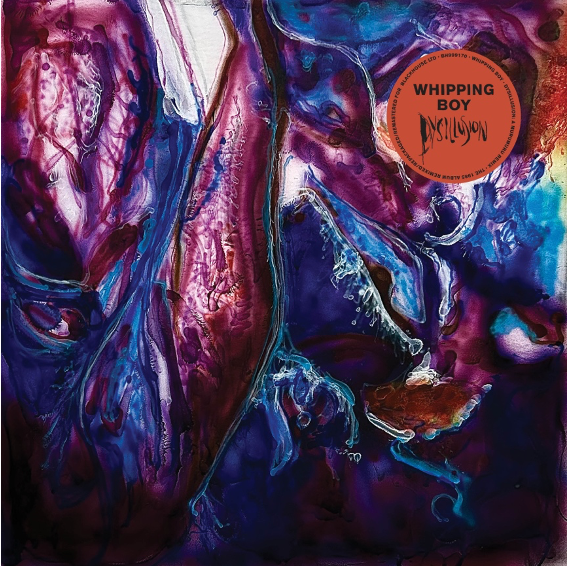
Before I get into this Dysillusion, I need to set the stage. This isn’t a review of a new album, although it is new. This is like an album reboot, a remake, a remix. But done with the best intentions, by original members. You can listen to this album without hearing the original, but to get a sense of what has been accomplished, you should track down the original to compare.
An original that means a lot to me.
Some albums seem to spin me back into specific moments in time. Different people, different places, different lives. After spending a few decades listening to music, I’ve accumulated a lot of those. Most of them are like sonic snapshots. A kiss, a drink, a party, a break-up, a best friend, a lost friend. Others hold more history. An entire relationship, a summer, a shift in your interests and tastes. Whipping Boy’s Muru Muru, released in 1984, is one of the latter. A beautifully dark and obscure album that, for me, is overflowing with music that holds intense, vivid, visceral, and immediate reactions.
I didn’t experience Muru Muru until 1986, but in 1985 I was listening to Tears for Fears, Talking Heads, and The Cure. In 1987 it was the Butthole Surfers, Sonic Youth, and Big Black (just to name a few). So 1986 was a year that created a spike in my brain that my musical tastes used to spin around, and bands like The Birthday Party, Nurse With Wound, Die Kruezen, No Trend, Killdozer, and Whipping Boy were in the middle of that spin.
Whipping Boy was born in 1981 when the energies between vocalist Eugene Robinson (Buñel, Oxbow) and guitarist Steve Ballinger came together and created what initially was a hardcore band. The Sound of One Hand Clapping came out in 1983, and Muru Muru hit a year later. Drums by Dave Owens, Sam Smoot handling the bass. Originally recorded by Klaus Flouride (Dead Kennedys), the album is intense. A move away from the thrash of the previous LP into more experimental and darker sounds. It was thick and swampy and heavy. Tribal beats and droning rhythms. Quotes from Apocalypse Now and paranoid ramblings creeping through sinister noise. It was, literally, a trip.
And now I listen to this “remix”, and hope it pays respect to my memory.
The track list is a little different, but it makes sense. We start with “Nevermore”. A dark post punked drawl that crawls into your throat and sticks. I can make out the vocals, I can hear the guitar pulling away from the bass, and the drums. The groove of “My Day At The Lake” is solid, a little early Faith No More swagger sliding under slight Jello Biafra touched vocals that curl into a Bad Brains growl. “Sunshine Nelly” is even more of a nightmare than it used to be, and I mean that in the best way possible. It’s harsh and moody and dark and emotional. I feel it.
“Mister Magi”, in my mind, was always the single. Evil whispers shifting into a fog under an early Sonic Youth drum attack while the guitars and vocals call out with an early grunge grit. “Interlude” and “Walking Boss” are little sound bites, possibly used to clear the sonic palate before exiting with “Once In A Lifetime” and “Junkman”.
“Once In A Lifetime” is a wondrous track. It shines alongside that post punk pre grunge left of the dial alternative experimentation of the early 80’s. Put it right beside Sonic Youth’s “Society Is a Hole”, “The Empty World” by The Cure, and “Never Tell” by the Violent Femmes. It would have been a great ending to a fantastic album, but then you say, “Nah, let’s close the album with a different song.”
And you finish with “Junkyard”.
A sprawling death blues classic that captures something similar to Iggy Pop crawling over the Beasts of Bourbon while Nick Cave laughs and watches as Tom Waits attempts to cover a song that might have been written by Green River. It’s perfect.
I am so happy with this revisitation. It enhances the memory. It pushes the meaning and the depth into the foreground, while the background is still attached to the time and the state in which the songs were originally created. I don’t know if my mind could have handled this version 40 years ago, but I’m glad … no … ecstatic to be hearing it now.
Robinson and Ballinger, working with producer / sound engineer Joe Chiccarelli (White Stripes, Steve Wynn, Oxbow), have brought an entire album back to life. It’s not an easy listen. It’s punk, it’s goth, it’s post-both. It’s experimental and melodic. It’s electric and dangerous. It’s of a time that no longer exists, but it’s also a time machine. It is an album that was built upon anguish and drugs, angst and disillusionment, but it was also created to be something new. To be a catalyst, a voice for and of change. It was meant to open doors, and now those doors can, and probably need to be, opened.
Play it loud, and listen.